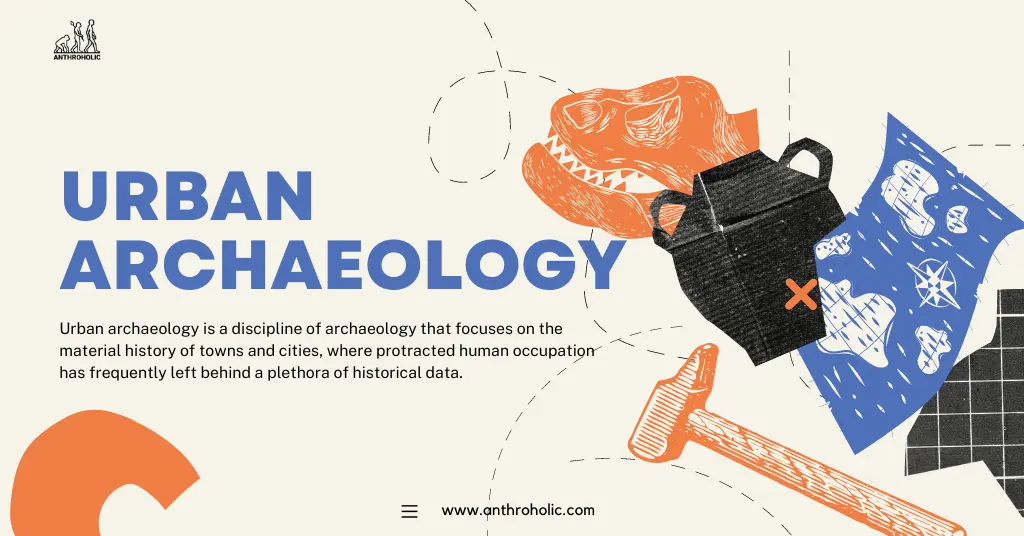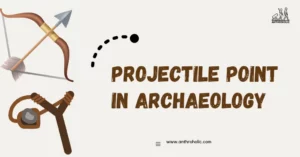AI Answer Evaluation Platform Live Now. Try Free Answer Evaluation Now
Urban Archaeology
Urban archaeology is a discipline of archaeology that focuses on the material history of towns and cities, where protracted human occupation has frequently left behind a plethora of historical data. When someone speaks of living in a city in the modern age, they are referring to an area with a lot of surrounding neighbors and typically fairly towering buildings. Cities are important repositories of archaeological evidence because of their infrastructure and large populations. A significant technique for urban archaeology has been employed throughout time, along with crucial historical advancements.

Big human populations result in big human populations of waste. Small groups of people may dispose of their rubbish locally without raising vermin or jeopardizing their health, but large numbers of people must dispose of kitchen waste, broken goods, and similar stuff. Around 5,000 years ago, as populations began to grow, these procedures started to become problematic, and items were frequently hauled into these new settlements but never removed.
A study of urban archaeology can provide insight into the economic, social, and racial dynamics and histories of modern and ancient cities, as well as their environmental effects.
Before regular garbage collection became prevalent in urban places in the nineteenth century, people always tossed their trash out of their windows or buried it in their gardens. When there were no planning rules in existence, it was usual for homes to fall. When this occurred, the owners would recover what they could, level the wreckage, and then build new dwellings on the same site. Artifacts such as these, along with the previous impacts of modern technology such as sanitation, commerce, and transportation services, are commonly used to categorize archaeological studies of urban areas.
This has the consequence that even a moderately sized settlement from antiquity is raised past its original height on an archaeological plateau by being constructed on top of a mound of debris and ruined buildings. Most visible are the Near Eastern tel sites, which are raised up several meters above the surrounding landscape and have been occupied for thousands of years.
Purpose of Urban archaeology

The purpose of the surrounding walls of walled towns, like those in mediaeval Europe, was to hold in the waste so that it could not flow beyond, compounding the damage. Redevelopment of urban areas and archaeological excavations have become an integral part of modern urban life, which is why urban archaeological studies are typically of great interest to the public. However, developers should take care when releasing content that can possibly provoke public sentiment. With the cooperation of the public, archaeologists may explain the history and relevance of their discoveries through urban archaeology.
Historical Perspective
As a consequence, extensive stratigraphies that date back to the city’s original establishment and describe its history are commonly unearthed during archaeological digs inside old towns.
There is a long history of urban excavation in the City of London, dating back to the late 1900s. These excavations, carried out in highly occupied sections of the city, found historical evidence of hitherto unrecognised events. London is situated on a tower that still has a layer of black material on it from when Boudica set the city on fire in 60 AD. These finds could only be obtained by excavation of the urban areas, as the city had already outgrown its original borders by the time it was reconstructed some years after the Boudican insurrection.
Another outstanding example is the city of Turku, which was created in the Middle Ages and is situated in southwest Finland. Since the city’s establishment, no trustworthy documents have been preserved, and unending excavations are done there every year to discover more about the city’s early beginnings.
The archaeologists who originally excavated such communities had challenges thanks to the intricate stratigraphy of the sites. Early excavations were generally relegated to rural locations or long-abandoned communities. Due to the enormous expanse and the possibility to frequently disclose the archaeology just in advance, open-area excavation was conceivable. However, in inhabited locations, excavation space is generally restricted to the size of the open plot, and each layer of archaeology must be disclosed before going on to the next.
Rome was also a notable archaeological site as it was regarded as being well-established and evolving through time. There have been various excavations undertaken, which archaeologists have subsequently examined. W.F. Grimes was one archaeologist who dedicated a lot of time to investigating Roman archaeology.
These types of challenges had previously appeared at Pompeii or at multi-phase rural sites, but the examination of cities, which began in Europe after World War II, was a new path. Since the war, urban excavation has become more popular in places like Europe, the East Coast of the United States, and other western world cities. The possibility of losing relics associated with early civilizations was identified as a consequence of the bombing of landscapes during the conflict. The notion of settlement is founded on the assumption that settlements are created where resources are conveniently available. Due to their ready access to resources, affluent communities like Boston and London soon flourished from their origins as tiny villages. However, the fact that these cities are still standing today does not rule out the possibility that another civilization once existed there.
What kind of archaeological records are there in cities?

The measures involve an attempt to appreciate the degree of integrity and preservation of the archaeological record. Given that the city has witnessed large and numerous land modifications, this is a field of investigation that is particularly relevant for urban archaeology. Although research results typically reveal that much information has been extremely well preserved, many archaeologists underline the detrimental impact that such operations have on the deposited material.
The physical characteristics of a city’s internal structure must be taken into consideration in order to make a major assessment concerning preservation. The true objectives for which the land is utilized and the tangible effects of those goals are its physical features. Urban people’s transience, superficiality, and anonymity of thinking are nonphysical (social) traits. Land-use patterns may be determined in part by attitudes and demographics. The site selection features that are used to make decisions about how to use any particular land parcel reflect the developer’s behavioral norms. However, land use directly impacts the nature and speed of garbage accumulation in urban areas.
The System of Classification
Urban planners typically design land-use categories that are suited to the needs of a given city or a small group of cities. Though various attempts have been made, it is tough to discover a category that has equivalent applicability. In this article, numerous forms of urban land use are described, including highways, empty land, single-family dwellings, multifamily housing, mobile homes, commercial, industrial, and public uses of land. For a variety of reasons, broad categories were picked.
Solitary-family homes
- The house is the largest structure on the land, with storage sheds and smaller structures like garages also present.
- The overall feeling of the area is one of open space, although the exact proportion of open space versus infrastructure is unknown.
- Aerial pictures can provide insight into the amount of open space in the area and are commonly stored in municipal and county offices, libraries, academic institutions, and planning group archives.
- The socioeconomic neighborhood is a practical unit of inquiry for acquiring data on open space, as it is likely that open space increases with family prosperity.
- In urban areas, approximately one-third of the land is typically used for single-family houses.
- The archaeological record at this site has not undergone significant revisions, and there is a significant amount of undisturbed soil even with the presence of wells, cisterns, gardens, work sheds, and other structures.
- Newly developed towns have great potential for preserving preurban ancient sites that are near the surface or deeply buried, especially if significant ground surface changes were not part of the construction process.
- Archaeologists can conduct small-scale tests and surveys to add to the archaeological record over time, similar to the Cultural Resource Management section of the Arizona State Museum.
- Prehistoric remains are initially covered by historic urban material in archaeological contexts, and the gradual and unplanned disposal of such land has led to the accumulation of the record over time.
- The old preurban material may consist of various forms of agglomeration, and understanding preurban land-use patterns is crucial for predicting the types of sites or artifacts that may be discovered.
- Historic urban material, including artifacts used for residential purposes, makes up the collection of artifacts, and their frequency, presence/absence, and spatial content are important factors to consider when studying domestic artifacts.
Multi family Homes of Urban archaeology
Any structure meant to accommodate more than one family in separate quarters is referred to as a “multifamily dwelling.” These residences range in size from small apartment buildings that may accommodate two or three families to gigantic apartment complexes that may accommodate hundreds. The biggest of these homes is the focus of this debate.
Mobile Residences of Urban archaeology
The fourth type of housing may include mobile homes and trailers, which are typically immovable and located in specific areas. Despite quickly becoming a prominent American house type, there are no comparable figures on the average amount of urban land allotted to these units. In the western and southern states, this growth is especially fast.
This sort of habitation disrupts archaeological material that has previously been deposited the least. These constructions don’t have foundations, so they scarcely alter the archaeological record underneath them. What little there is came about as a consequence of modest land disturbance for the development of highways and to assure structural soundness. There could be well-preserved ancient preurban relics throughout the area where movable houses are found. However, owing to the recent construction of the bulk of these places and their temporary nature, little in the way of a historic-period archaeological record will be available.
Public Use Areas of Urban archaeology
All land that the general public has access to is regarded as being in zones of public use. Additionally, semipublic locations like church grounds and private school yards are included. Public lands used as highways are not included owing to their peculiar spatial layout.
Recreational property, school land, cemetery land, and church land are the four kinds of public land described by Northan. His categorizations are based on the characteristics of the institution that owns the land, which results in variations in how the land is used, where the land is located within the city, the level of disturbance to the archaeological record, and the level of accessibility provided to archaeologists.
Conclusion
Urban societies around the world have produced a remarkable and enormous amount of archaeological evidence, and the information gleaned from urban sites using techniques like remote sensing and micromorphology can teach us a lot about cultural constructions, environmental problems, and social evolution.
The limits of urban archaeology include The unique challenges posed by working in such contexts set it apart from other branches of the discipline: excavation is typically in response to development (or redevelopment, more frequently) rather than research, so the locations and sizes of those sites are decided by the agencies of development; the timetables are frequently constrained; the stratigraphies are typically very deep, even in cities of modern origin; and according to this definition, urban archaeology is most often performed in nations with legal protections for possible finds.




